The Suitability Assessment of Agricultural Drought Monitoring Indices: A Case Study in Inland River Basin
Abstract
1. Introduction
2. Materials and Methods
2.1. Study Area
2.2. Datasets and Pre-Processing
2.2.1. Climate Data
2.2.2. Remote Sensing Data
2.2.3. Land Use and Other Auxiliary Data
2.3. Methods
2.3.1. Introduction of Drought Indices
2.3.2. Correlation Analysis
2.3.3. Trend Analysis
3. Results
3.1. Correlation Analysis of Drought Indices and NPP
3.2. Temporal Trends of Agricultural Drought
3.3. Spatial Distribution of Agricultural Drought Trend
4. Discussion
4.1. Suitability Indices for Agricultural Drought Monitoring in the Shiyang River Basin
4.2. The Contrasting Trend between Meteorological and Agricultural Drought
4.3. The Importance of Runoff Information in Agricultural Drought Monitoring for Inland River Basin
4.4. The Imperative of Constructing Integrated Drought Indices
4.5. Practical Implication and Limitations
5. Conclusions
Author Contributions
Funding
Data Availability Statement
Acknowledgments
Conflicts of Interest
Appendix A
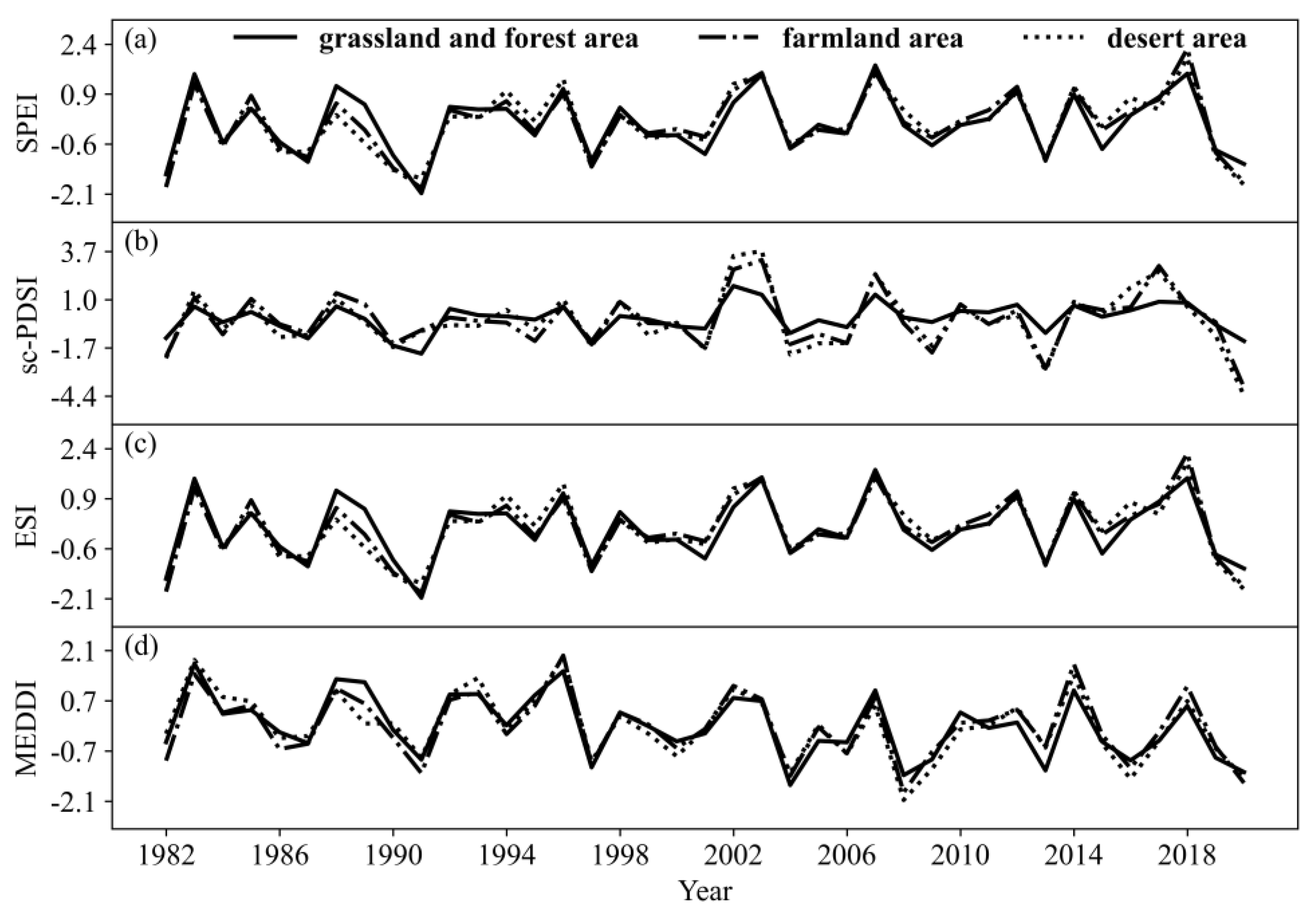
| SPEI | sc-PDSI | ESI | MEDDI | |
| Grassland and forest area | 0.10/10a | 0.13/10a | 0.10/10a | −0.32/10a ** |
| Farmland area | 0.16/10a | 0.02/10a | 0.16/10a | −0.1710a |
| Desert area | 0.22/10a | 0.16/10a | 0.22/10a | −0.30/10a ** |
References
- Hao, Z.; Singh, V.P. Drought Characterization from a Multivariate Perspective: A Review. J. Hydrol. 2015, 527, 668–678. [Google Scholar] [CrossRef]
- Dong, Z.; Liu, H.; Baiyinbaoligao; Hu, H.; Khan, M.Y.A.; Wen, J.; Chen, L.; Tian, F. Future Projection of Seasonal Drought Characteristics Using CMIP6 in the Lancang-Mekong River Basin. J. Hydrol. 2022, 610, 127815. [Google Scholar] [CrossRef]
- Zargar, A.; Sadiq, R.; Naser, B.; Khan, F.I. A Review of Drought Indices. Environ. Rev. 2011, 19, 333–349. [Google Scholar] [CrossRef]
- Mishra, A.K.; Singh, V.P. A Review of Drought Concepts. J. Hydrol. 2010, 391, 202–216. [Google Scholar] [CrossRef]
- Liu, X.; Zhu, X.; Pan, Y.; Li, S.; Liu, Y.; Ma, Y. Agricultural drought monitor: Progress, challenges and prospect. Acta Geogr. Sin. 2015, 70, 1835–1848. [Google Scholar] [CrossRef]
- Jürgen, V.; Wadid, E.; Roger, P.; Et, A.; Marc, G. (Eds.) Special Report on Drought 2021 (United Nations); United Nations: New York, NY, USA, 2021; ISBN 978-92-1-232027-4.
- Gao, C.; Zhao, Q.; Zhang, F. Research Progress of Agricultural Drought Disaster Based on Bibliometric Analysis of Chinese Literature. J. North China Univ. Water Resour. Electr. Power (Nat. Sci. Ed.) 2022, 43, 1–9. [Google Scholar] [CrossRef]
- Huang, S.; Huang, Q.; Chang, J.; Leng, G.; Xing, L. The Response of Agricultural Drought to Meteorological Drought and the Influencing Factors: A Case Study in the Wei River Basin, China. Agric. Water Manag. 2015, 159, 45–54. [Google Scholar] [CrossRef]
- Zhao, Z.; Wang, K. Capability of Existing Drought Indices in Reflecting Agricultural Drought in China. JGR Biogeosciences 2021, 126. [Google Scholar] [CrossRef]
- Cartwright, J.M.; Littlefield, C.E.; Michalak, J.L.; Lawler, J.J.; Dobrowski, S.Z. Topographic, Soil, and Climate Drivers of Drought Sensitivity in Forests and Shrublands of the Pacific Northwest, USA. Sci. Rep. 2020, 10, 18486. [Google Scholar] [CrossRef]
- Dietz, K.-J.; Zörb, C.; Geilfus, C.M. Drought and Crop Yield. Plant Biol. J. 2021, 23, 881–893. [Google Scholar] [CrossRef]
- Afshar, M.H.; Bulut, B.; Duzenli, E.; Amjad, M.; Yilmaz, M.T. Global Spatiotemporal Consistency between Meteorological and Soil Moisture Drought Indices. Agric. For. Meteorol. 2022, 316, 108848. [Google Scholar] [CrossRef]
- Zarch, M.A.A.; Sivakumar, B.; Sharma, A. Droughts in a Warming Climate: A Global Assessment of Standardized Precipitation Index (SPI) and Reconnaissance Drought Index (RDI). J. Hydrol. 2015, 526, 183–195. [Google Scholar] [CrossRef]
- Shahzaman, M.; Zhu, W.; Bilal, M.; Habtemicheal, B.A.; Mustafa, F.; Arshad, M.; Ullah, I.; Ishfaq, S.; Iqbal, R. Remote Sensing Indices for Spatial Monitoring of Agricultural Drought in South Asian Countries. Remote Sens. 2021, 13, 2059. [Google Scholar] [CrossRef]
- Tian, L.; Yuan, S.; Quiring, S.M. Evaluation of Six Indices for Monitoring Agricultural Drought in the South-Central United States. Agric. For. Meteorol. 2018, 249, 107–119. [Google Scholar] [CrossRef]
- Samarasinghe, G.B. Growth and Yields of Sri Lanka’s Major Crops Interpreted from Public Domain Satellites. Agric. Water Manag. 2003, 58, 145–157. [Google Scholar] [CrossRef]
- Karthikeyan, L.; Chawla, I.; Mishra, A.K. A Review of Remote Sensing Applications in Agriculture for Food Security: Crop Growth and Yield, Irrigation, and Crop Losses. J. Hydrol. 2020, 586, 124905. [Google Scholar] [CrossRef]
- Wan, W.; Liu, Z.; Li, J.; Xu, J.; Wu, H.; Xu, Z. Spatiotemporal Patterns of Maize Drought Stress and Their Effects on Biomass in the Northeast and North China Plain from 2000 to 2019. Agric. For. Meteorol. 2022, 315, 108821. [Google Scholar] [CrossRef]
- Nanzad, L.; Zhang, J.; Tuvdendorj, B.; Yang, S.; Rinzin, S.; Prodhan, F.A.; Sharma, T.P.P. Assessment of Drought Impact on Net Primary Productivity in the Terrestrial Ecosystems of Mongolia from 2003 to 2018. Remote Sens. 2021, 13, 2522. [Google Scholar] [CrossRef]
- Wang, X.; Chen, J.M.; Ju, W. Photochemical Reflectance Index (PRI) Can Be Used to Improve the Relationship between Gross Primary Productivity (GPP) and Sun-Induced Chlorophyll Fluorescence (SIF). Remote Sens. Environ. 2020, 246, 111888. [Google Scholar] [CrossRef]
- Cao, D.; Zhang, J.; Han, J.; Zhang, T.; Yang, S.; Wang, J.; Prodhan, F.A.; Yao, F. Projected Increases in Global Terrestrial Net Primary Productivity Loss Caused by Drought Under Climate Change. Earth’s Future 2022, 10, e2022EF002681. [Google Scholar] [CrossRef]
- Wang, Q.; Yang, Y.; Liu, Y.; Tong, L.; Zhang, Q.; Li, J. Assessing the Impacts of Drought on Grassland Net Primary Production at the Global Scale. Sci Rep 2019, 9, 14041. [Google Scholar] [CrossRef] [PubMed]
- Lai, C.; Li, J.; Wang, Z.; Wu, X.; Zeng, Z.; Chen, X.; Lian, Y.; Yu, H.; Wang, P.; Bai, X. Drought-Induced Reduction in Net Primary Productivity across Mainland China from 1982 to 2015. Remote Sens. 2018, 10, 1433. [Google Scholar] [CrossRef]
- Mu, Q.; Zhao, M.; Kimball, J.S.; McDowell, N.G.; Running, S.W. A Remotely Sensed Global Terrestrial Drought Severity Index. Bull. Am. Meteorol. Soc. 2013, 94, 83–98. [Google Scholar] [CrossRef]
- Wei, W.; Pang, S.; Wang, X.; Zhou, L.; Xie, B.; Zhou, J.; Li, C. Temperature Vegetation Precipitation Dryness Index (TVPDI)-Based Dryness-Wetness Monitoring in China. Remote Sens. Environ. 2020, 248, 111957. [Google Scholar] [CrossRef]
- Chen, J. Analysis on Water Resources Utilization and Ecological Protection under the Irreversibility of Drought Climate in Northwest Inland Rivers- Take Aiding Lake Basin and Shiyang River Basin as Examples. Gansu Water Resour. Hydropower Technol. 2021, 57, 6–9+27. [Google Scholar] [CrossRef]
- Zhou, J.; Zhao, Y.; Huang, P.; Zhao, X.; Feng, W.; Li, Q.; Xue, D.; Dou, J.; Shi, W.; Wei, W.; et al. Impacts of Ecological Restoration Projects on the Ecosystem Carbon Storage of Inland River Basin in Arid Area, China. Ecol. Indic. 2020, 118, 106803. [Google Scholar] [CrossRef]
- Wang, Y.; Zhao, J.; Fu, J.; Wei, W. Effects of the Grain for Green Program on the Water Ecosystem Services in an Arid Area of China—Using the Shiyang River Basin as an Example. Ecol. Indic. 2019, 104, 659–668. [Google Scholar] [CrossRef]
- Jiang, L.; An, P. Temporal and Spatial Distribution and Grain Risk Assessment of Nature Disasters in China. J. Catastrophology 2011, 26, 19–48. [Google Scholar]
- Jia, D.; Li, K.; Nie, X.; Yuan, C.; Li, Q.; Gao, F. Prediction model of summer land surface temperature in the Shiyang River basin based on the wavelet transform and neural network. Journal of Glaciology and Geocryology 2020, 42, 412–422. [Google Scholar] [CrossRef]
- Tian, F.; Zhang, Y.; Lu, S. Spatial-Temporal Dynamics of Cropland Ecosystem Water-Use Efficiency and the Responses to Agricultural Water Management in the Shiyang River Basin, Northwestern China. Agric. Water Manag. 2020, 237, 106176. [Google Scholar] [CrossRef]
- Abatzoglou, J.T.; Dobrowski, S.Z.; Parks, S.A.; Hegewisch, K.C. TerraClimate, a High-Resolution Global Dataset of Monthly Climate and Climatic Water Balance from 1958–2015. Sci Data 2018, 5, 170191. [Google Scholar] [CrossRef] [PubMed]
- Qin, Y.; Abatzoglou, J.T.; Siebert, S.; Huning, L.S.; AghaKouchak, A.; Mankin, J.S.; Hong, C.; Tong, D.; Davis, S.J.; Mueller, N.D. Agricultural Risks from Changing Snowmelt. Nat. Clim. Chang. 2020, 10, 459–465. [Google Scholar] [CrossRef]
- Burrell, A.L.; Evans, J.P.; De Kauwe, M.G. Anthropogenic Climate Change Has Driven over 5 Million Km2 of Drylands towards Desertification. Nat Commun 2020, 11, 3853. [Google Scholar] [CrossRef] [PubMed]
- Chen, H.; Sun, J. Changes in Drought Characteristics over China Using the Standardized Precipitation Evapotranspiration Index. J. Clim. 2015, 28, 5430–5447. [Google Scholar] [CrossRef]
- Park Williams, A.; Allen, C.D.; Macalady, A.K.; Griffin, D.; Woodhouse, C.A.; Meko, D.M.; Swetnam, T.W.; Rauscher, S.A.; Seager, R.; Grissino-Mayer, H.D.; et al. Temperature as a Potent Driver of Regional Forest Drought Stress and Tree Mortality. Nat. Clim Chang. 2013, 3, 292–297. [Google Scholar] [CrossRef]
- Sun, Z.; Di, L. Intercomparison of Agricultural Drought Monitoring Products. In Proceedings of the 2021 9th International Conference on Agro-Geoinformatics (Agro-Geoinformatics), Shenzhen, China, 26 July 2021; pp. 1–5. [Google Scholar]
- Wu, B.; Ma, Z.; Yan, N. Agricultural Drought Mitigating Indices Derived from the Changes in Drought Characteristics. Remote Sens. Environ. 2020, 244, 111813. [Google Scholar] [CrossRef]
- Pei, F.; Wu, C.; Liu, X.; Li, X.; Yang, K.; Zhou, Y.; Wang, K.; Xu, L.; Xia, G. Monitoring the Vegetation Activity in China Using Vegetation Health Indices. Agric. For. Meteorol. 2018, 248, 215–227. [Google Scholar] [CrossRef]
- Van Hoolst, R.; Eerens, H.; Haesen, D.; Royer, A.; Bydekerke, L.; Rojas, O.; Li, Y.; Racionzer, P. FAO’s AVHRR-Based Agricultural Stress Index System (ASIS) for Global Drought Monitoring. Int. J. Remote Sens. 2016, 37, 418–439. [Google Scholar] [CrossRef]
- Kogan, F.N. Application of Vegetation Index and Brightness Temperature for Drought Detection. Adv. Space Res. 1995, 15, 91–100. [Google Scholar] [CrossRef]
- Zeng, J.; Zhang, R.; Qu, Y.; Bento, V.A.; Zhou, T.; Lin, Y.; Wu, X.; Qi, J.; Shui, W.; Wang, Q. Improving the Drought Monitoring Capability of VHI at the Global Scale via Ensemble Indices for Various Vegetation Types from 2001 to 2018. Weather Clim. Extrem. 2022, 35, 100412. [Google Scholar] [CrossRef]
- Zhong, S.; Di, L.; Sun, Z.; Xu, Z.; Guo, L. Investigating the Long-Term Spatial and Temporal Characteristics of Vegetative Drought in the Contiguous United States. IEEE J. Sel. Top. Appl. Earth Obs. Remote Sens. 2019, 12, 836–848. [Google Scholar] [CrossRef]
- Cui, J.; Wang, Y.; Zhou, T.; Jiang, L.; Qi, Q. Temperature Mediates the Dynamic of MODIS NPP in Alpine Grassland on the Tibetan Plateau, 2001–2019. Remote Sens. 2022, 14, 2401. [Google Scholar] [CrossRef]
- Wang, Z.; Wang, H.; Wang, T.; Wang, L.; Huang, X.; Zheng, K.; Liu, X. Effects of Environmental Factors on the Changes in MODIS NPP along DEM in Global Terrestrial Ecosystems over the Last Two Decades. Remote Sens. 2022, 14, 713. [Google Scholar] [CrossRef]
- Zhao, M.; Heinsch, F.; Nemani, R.; Running, S. Improvements of the MODIS Terrestrial Gross and Net Primary Production Global Data Set. Remote Sens. Environ. 2005, 95, 164–176. [Google Scholar] [CrossRef]
- Zhang, Z.; Xu, W.; Qin, Q.; Chen, Y. Monitoring and Assessment of Agricultural Drought Based on Solar-Induced Chlorophyll Fluorescence During Growing Season in North China Plain. IEEE J. Sel. Top. Appl. Earth Obs. Remote Sens. 2021, 14, 775–790. [Google Scholar] [CrossRef]
- Mukherjee, S.; Mishra, A.K. Increase in Compound Drought and Heatwaves in a Warming World. Geophys. Res. Lett. 2021, 48, e2020GL090617. [Google Scholar] [CrossRef]
- Jiang, R.; Xie, J.; He, H.; Luo, J.; Zhu, J. Use of Four Drought Indices for Evaluating Drought Characteristics under Climate Change in Shaanxi, China: 1951–2012. Nat. Hazards 2015, 75, 2885–2903. [Google Scholar] [CrossRef]
- Vicente-Serrano, S.M.; Beguería, S.; López-Moreno, J.I. A Multiscalar Drought Index Sensitive to Global Warming: The Standardized Precipitation Evapotranspiration Index. J. Clim. 2010, 23, 1696–1718. [Google Scholar] [CrossRef]
- Wells, N.; Goddard, S.; Hayes, M.J. A Self-Calibrating Palmer Drought Severity Index. J. Clim. 2004, 17, 2335–2351. [Google Scholar] [CrossRef]
- Anderson, M.C.; Zolin, C.A.; Sentelhas, P.C.; Hain, C.R.; Semmens, K.; Tugrul Yilmaz, M.; Gao, F.; Otkin, J.A.; Tetrault, R. The Evaporative Stress Index as an Indicator of Agricultural Drought in Brazil: An Assessment Based on Crop Yield Impacts. Remote Sens. Environ. 2016, 174, 82–99. [Google Scholar] [CrossRef]
- Hobbins, M.T.; Wood, A.; McEvoy, D.J.; Huntington, J.L.; Morton, C.; Anderson, M.; Hain, C. The Evaporative Demand Drought Index. Part I: Linking Drought Evolution to Variations in Evaporative Demand. J. Hydrometeorol. 2016, 17, 1745–1761. [Google Scholar] [CrossRef]
- Souza, A.G.S.S.; Ribeiro Neto, A.; Souza, L.L. de Soil Moisture-Based Index for Agricultural Drought Assessment: SMADI Application in Pernambuco State-Brazil. Remote Sens. Environ. 2021, 252, 112124. [Google Scholar] [CrossRef]
- Wu, W.; Geller, M.A.; Dickinson, R.E. The Response of Soil Moisture to Long-Term Variability of Precipitation. J. Hydrometeorol. 2002, 3, 604–613. [Google Scholar] [CrossRef]
- Liu, W.T.; Kogan, F.N. Monitoring Regional Drought Using the Vegetation Condition Index. Int. J. Remote Sens. 1996, 17, 2761–2782. [Google Scholar] [CrossRef]
- Sandholt, I.; Rasmussen, K.; Andersen, J. A Simple Interpretation of the Surface Temperature/Vegetation Index Space for Assessment of Surface Moisture Status. Remote Sens. Environ. 2002, 79, 213–224. [Google Scholar] [CrossRef]
- Chang, S.; Wu, B.; Yan, N.; Davdai, B.; Nasanbat, E. Suitability Assessment of Satellite-Derived Drought Indices for Mongolian Grassland. Remote Sens. 2017, 9, 650. [Google Scholar] [CrossRef]
- Lu, J.; Carbone, G.J.; Gao, P. Mapping the Agricultural Drought Based on the Long-Term AVHRR NDVI and North American Regional Reanalysis (NARR) in the United States, 1981–2013. Appl. Geogr. 2019, 104, 10–20. [Google Scholar] [CrossRef]
- Labudová, L.; Labuda, M.; Takáč, J. Comparison of SPI and SPEI Applicability for Drought Impact Assessment on Crop Production in the Danubian Lowland and the East Slovakian Lowland. Appl. Clim. 2017, 128, 491–506. [Google Scholar] [CrossRef]
- Hao, Z.; AghaKouchak, A. Multivariate Standardized Drought Index: A Parametric Multi-Index Model. Adv. Water Resour. 2013, 57, 12–18. [Google Scholar] [CrossRef]
- Wang, F.; Wang, Z.; Yang, H.; Zhao, Y.; Li, Z.; Wu, J. Capability of Remotely Sensed Drought Indices for Representing the Spatio–Temporal Variations of the Meteorological Droughts in the Yellow River Basin. Remote Sens. 2018, 10, 1834. [Google Scholar] [CrossRef]
- Zhao, X.; Xia, H.; Liu, B.; Jiao, W. Spatiotemporal Comparison of Drought in Shaanxi–Gansu–Ningxia from 2003 to 2020 Using Various Drought Indices in Google Earth Engine. Remote Sens. 2022, 14, 1570. [Google Scholar] [CrossRef]
- Sen, P.K. Estimates of the Regression Coefficient Based on Kendall’s Tau. null 1968, 63, 1379–1389. [Google Scholar] [CrossRef]
- Mann, H.B. Nonparametric Tests Against Trend. Econometrica 1945, 13, 245. [Google Scholar] [CrossRef]
- Sun, S.; Du, W.; Song, Z.; Zhang, D.; Wu, X.; Chen, B.; Wu, Y. Response of Gross Primary Productivity to Drought Time-Scales Across China. J. Geophys. Res. Biogeosciences 2021, 126, e2020JG005953. [Google Scholar] [CrossRef]
- Feng, W.; Lu, H.; Yao, T.; Yu, Q. Drought Characteristics and Its Elevation Dependence in the Qinghai–Tibet Plateau during the Last Half-Century. Sci. Rep. 2020, 10, 14323. [Google Scholar] [CrossRef]
- Chatterjee, S.; Desai, A.R.; Zhu, J.; Townsend, P.A.; Huang, J. Soil Moisture as an Essential Component for Delineating and Forecasting Agricultural Rather than Meteorological Drought. Remote Sens. Environ. 2022, 269, 112833. [Google Scholar] [CrossRef]
- Tian, S.; Renzullo, L.J.; van Dijk, A.I.J.M.; Tregoning, P.; Walker, J.P. Global Joint Assimilation of GRACE and SMOS for Improved Estimation of Root-Zone Soil Moisture and Vegetation Response. Hydrol. Earth Syst. Sci. 2019, 23, 1067–1081. [Google Scholar] [CrossRef]
- Luo, W.; Xu, X.; Liu, W.; Liu, M.; Li, Z.; Peng, T.; Xu, C.; Zhang, Y.; Zhang, R. UAV Based Soil Moisture Remote Sensing in a Karst Mountainous Catchment. CATENA 2019, 174, 478–489. [Google Scholar] [CrossRef]
- Zhou, K.; Li, J.; Zhang, T.; Kang, A. The Use of Combined Soil Moisture Data to Characterize Agricultural Drought Conditions and the Relationship among Different Drought Types in China. Agric. Water Manag. 2021, 243, 106479. [Google Scholar] [CrossRef]
- Wei, W.; Zhang, J.; Zhou, L.; Xie, B.; Zhou, J.; Li, C. Comparative Evaluation of Drought Indices for Monitoring Drought Based on Remote Sensing Data. Env. Sci Pollut Res 2021, 28, 20408–20425. [Google Scholar] [CrossRef] [PubMed]
- Li, L.; Liu, C. Changing Trend and Features of the Runoff from Mountain Areas of Rivers in Shiyang River Drainage Basin. J. Soil Water Conserv. 2011, 25, 58–63. [Google Scholar] [CrossRef]
- Wang, L.; Yu, H.; Yang, M.; Yang, R.; Gao, R.; Wang, Y. A Drought Index: The Standardized Precipitation Evapotranspiration Runoff Index. J. Hydrol. 2019, 571, 651–668. [Google Scholar] [CrossRef]
- Li, L.; Lu, T.; Liu, C.; Hu, L.; Wang, S. Characteristics of Hydrological Drought Based on Standardized Flow Index in Shiyang River Basin of China. J. Desert Res. 2020, 40, 24–33. [Google Scholar] [CrossRef]
- Li, Z.; Hao, Z.; Shi, X.; Déry, S.J.; Li, J.; Chen, S.; Li, Y. An Agricultural Drought Index to Incorporate the Irrigation Process and Reservoir Operations: A Case Study in the Tarim River Basin. Glob. Planet. Chang. 2016, 143, 10–20. [Google Scholar] [CrossRef]
- Shi, X.; Ding, H.; Wu, M.; Zhang, N.; Shi, M.; Chen, F.; Li, Y. Effects of Different Types of Drought on Vegetation in Huang-Huai-Hai River Basin, China. Ecol. Indic. 2022, 144, 109428. [Google Scholar] [CrossRef]
- Shah, D.; Mishra, V. Integrated Drought Index (IDI) for Drought Monitoring and Assessment in India. Water Resour. Res. 2020, 56, e2019WR026284. [Google Scholar] [CrossRef]
- Yu, H.; Zhang, Q.; Xu, C.-Y.; Du, J.; Sun, P.; Hu, P. Modified Palmer Drought Severity Index: Model Improvement and Application. Environ. Int. 2019, 130, 104951. [Google Scholar] [CrossRef]
- Liu, Y.; Yang, X.; Ren, L.; Yuan, F.; Jiang, S.; Ma, M. A New Physically Based Self-Calibrating Palmer Drought Severity Index and Its Performance Evaluation. Water Resour Manag. 2015, 29, 4833–4847. [Google Scholar] [CrossRef]
- Wu, J.; Miao, C.; Tang, X.; Duan, Q.; He, X. A Nonparametric Standardized Runoff Index for Characterizing Hydrological Drought on the Loess Plateau, China. Glob. Planet. Chang. 2018, 161, 53–65. [Google Scholar] [CrossRef]
- Svoboda, M.; LeComte, D.; Hayes, M.; Heim, R.; Gleason, K.; Angel, J.; Rippey, B.; Tinker, R.; Palecki, M.; Stooksbury, D.; et al. THE DROUGHT MONITOR. Bull. Amer. Meteor. Soc. 2002, 83, 1181–1190. [Google Scholar] [CrossRef]
- Sun, P.; Zhang, Q.; Wen, Q.; Singh, V.P.; Shi, P. Multisource Data-Based Integrated Agricultural Drought Monitoring in the Huai River Basin, China: Integrated Drought Monitoring. J. Geophys. Res. Atmos. 2017, 122, 10751–10772. [Google Scholar] [CrossRef]
- Jiao, W.; Wang, L.; Novick, K.A.; Chang, Q. A New Station-Enabled Multi-Sensor Integrated Index for Drought Monitoring. J. Hydrol. 2019, 574, 169–180. [Google Scholar] [CrossRef]
- Wu, J.; Zhou, L.; Liu, M.; Zhang, J.; Leng, S.; Diao, C. Establishing and Assessing the Integrated Surface Drought Index (ISDI) for Agricultural Drought Monitoring in Mid-Eastern China. Int. J. Appl. Earth Obs. Geoinf. 2013, 23, 397–410. [Google Scholar] [CrossRef]
- Li, R.; Chen, N.; Zhang, X.; Zeng, L.; Wang, X.; Tang, S.; Li, D.; Niyogi, D. Quantitative Analysis of Agricultural Drought Propagation Process in the Yangtze River Basin by Using Cross Wavelet Analysis and Spatial Autocorrelation. Agric. For. Meteorol. 2020, 280, 107809. [Google Scholar] [CrossRef]
- Yang, F.; Duan, X.; Guo, Q.; Lu, S.; Hsu, K. The Spatiotemporal Variations and Propagation of Droughts in Plateau Mountains of China. Sci. Total Environ. 2022, 805, 150257. [Google Scholar] [CrossRef] [PubMed]

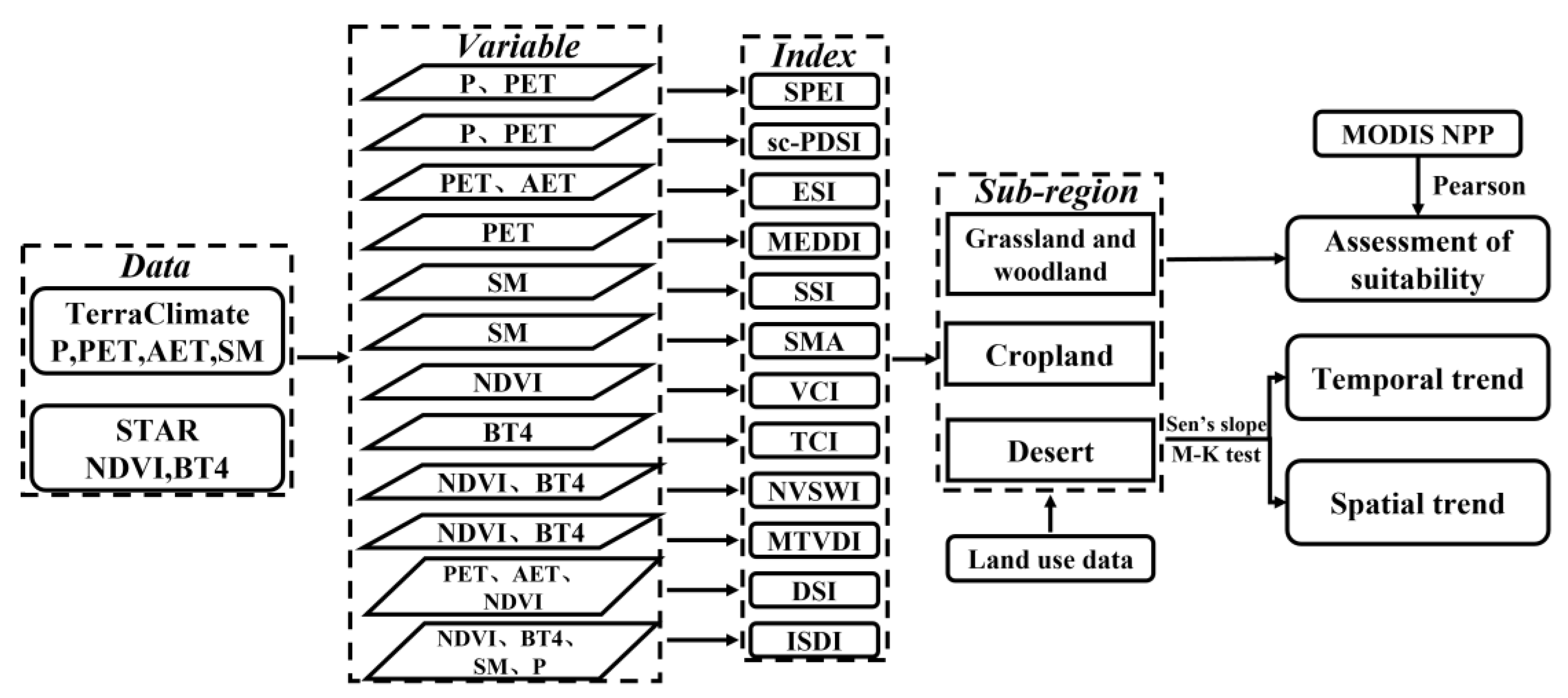

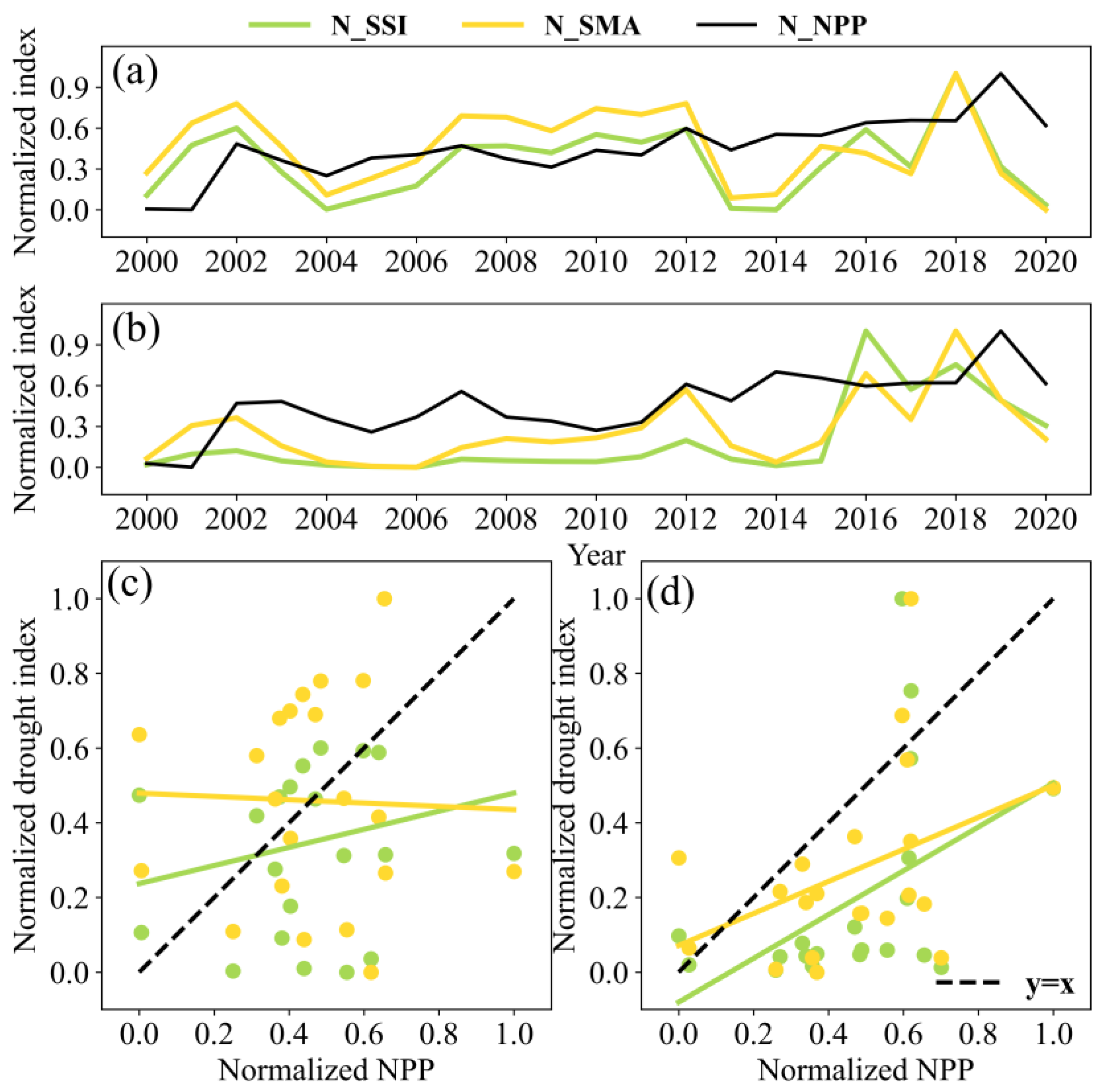
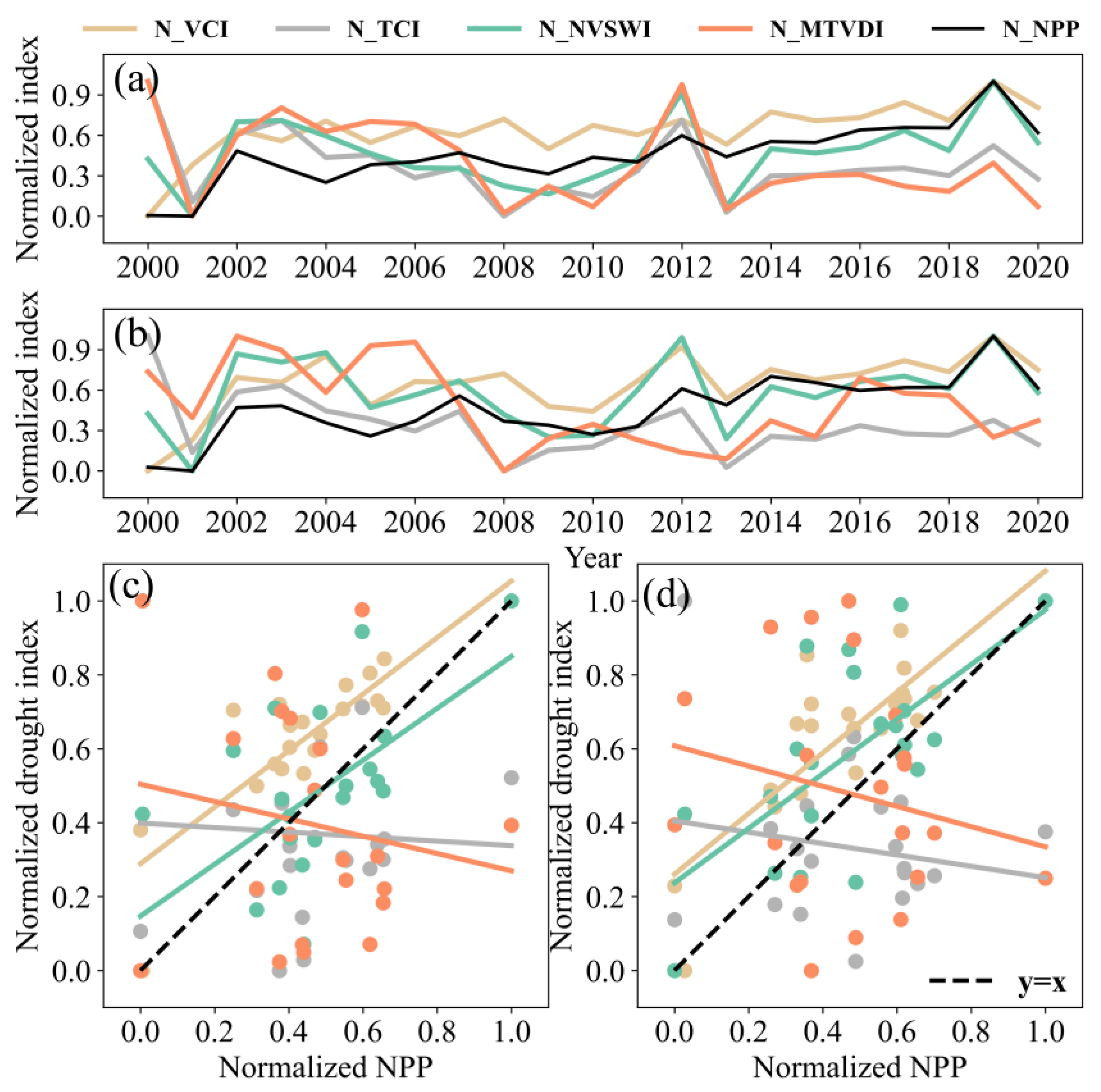


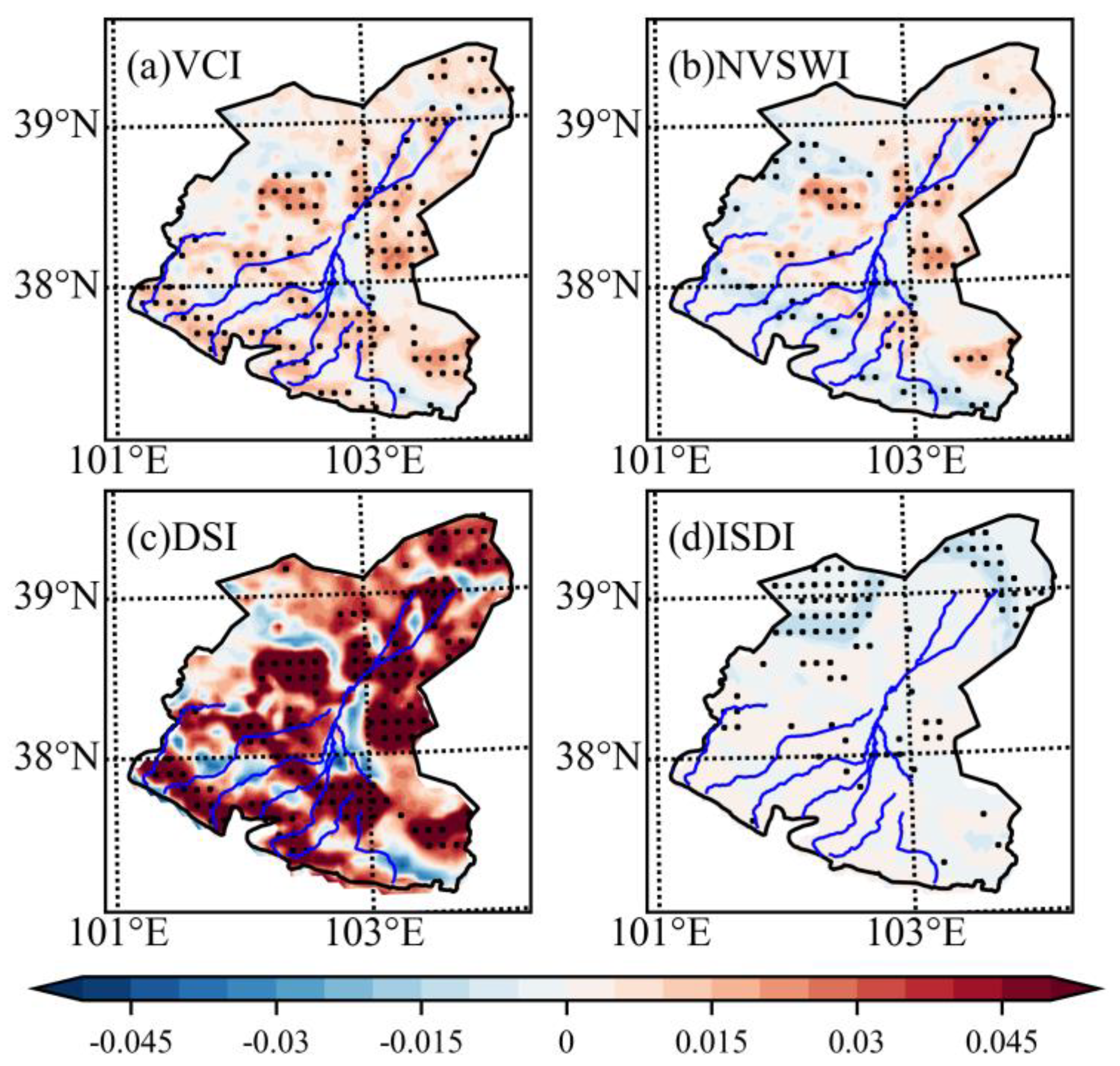
| Data | Temporal Resolution | Spatial Resolution | Time Domain | Sources |
|---|---|---|---|---|
| TerraClimate P, PET, AET and SM | 1 month | 4 km | 1982–2020 | http://www.climatologylab.org/terraclimate.html |
| STAR NDVI and BT4 | 1 week | 4 km | 1982–2020 | https://www.star.nesdis.noaa.gov/star/index.php |
| MODIS NPP | 1 year | 500 m | 2000–2020 | https://lpdaac.usgs.gov/products/mod17a3hgfv006/ |
| Land use data | No | 1 km | 2020 | https://www.resdc.cn/ |
| AWC | No | 0.083° | 2000 | https://webmap.ornl.gov/ogcdown/ |
| Indices | Formula | Variable Explanation | References |
|---|---|---|---|
| SPEI (Standardized Precipitation Evapotranspiration Index) | : Log-Logistic distribution function; and : Scale parameter, shape parameters and position parameters | [50] | |
| sc-PDSI (self-calibrating Palmer Drought Severity Index) | and : Persistence factor; and : Current month PDSI value and previous month PDSI value; : Current month moisture abnormalities | [51] | |
| ESI (Evaporative Stress Index) | ET: Actual evapotranspiration; PET: Potential evapotranspiration | [52] | |
| MEDDI (Modified Evaporative Demand Drought Index) | P: Cumulative probability; i: The rank of the cumulative quantity after sorting; n: Total number of samples | [53] | |
| SSI (Standardized Soil Moisture Index) | SM: Soil moisture in the growing season | [54] | |
| SMA (Soil Moisture Anomaly) | SM: Soil moisture | [55] | |
| VCI (Vegetation Condition Index) | NDVI: Normalized vegetation index | [56] | |
| TCI (Temperature Condition Index) | LST: Land surface temperature | [41] | |
| NVSWI (Normalized Vegetation Supply Water Index) | NDVI: Normalized vegetation index; LST: Land surface temperature | [57] | |
| MTVDI (Modified Temperature Vegetation Dryness Index) | a1 and b1: Dry-side fitting parameters; a2 and b2: Wet-side fitting parameters; LST Land surface temperature | [58] | |
| DSI (Drought Severity Index) | , | ET: Actual evapotranspiration; PET: Potential evapotranspiration; Z: Z-score Standardization | [24] |
| ISDI (Integrated Scaled Drought Index) | NDVI: Normalized vegetation index; LST: Land surface temperature; PCP: Precipitation; SM: Soil moisture | [59] |
| SPEI | sc-PDSI | ESI | MEDDI | SSI | SMA | VCI | TCI | NVSWI | MTVDI | DSI | ISDI | |
|---|---|---|---|---|---|---|---|---|---|---|---|---|
| Grassland and forest area | 0.146 | 0.238 | 0.198 | 0.042 | 0.207 | −0.035 | 0.857 ** | −0.056 | 0.623 ** | −0.167 | 0.559 ** | 0.331 |
| Farmland area | 0.171 | 0.242 | 0.153 | 0.165 | 0.482 ** | 0.391 * | 0.833 ** | −0.158 | 0.657 ** | −0.209 | 0.406 * | 0.508 ** |
| VCI | NVSWI | DSI | ISDI | |
|---|---|---|---|---|
| Grassland and forest area | 0.06/10a ** | −0.01/10a | 0.23/10a * | 0.00/10a |
| Farmland area | 0.09/10a ** | 0.05/10a * | 0.43/10a ** | 0.00/10a |
| Desert area | 0.04/10a * | 0.01/10a | 0.23/10a * | −0.03/10a ** |
Disclaimer/Publisher’s Note: The statements, opinions and data contained in all publications are solely those of the individual author(s) and contributor(s) and not of MDPI and/or the editor(s). MDPI and/or the editor(s) disclaim responsibility for any injury to people or property resulting from any ideas, methods, instructions or products referred to in the content. |
© 2023 by the authors. Licensee MDPI, Basel, Switzerland. This article is an open access article distributed under the terms and conditions of the Creative Commons Attribution (CC BY) license (https://creativecommons.org/licenses/by/4.0/).
Share and Cite
Liu, W.; Ma, S.; Feng, K.; Gong, Y.; Liang, L.; Tsubo, M. The Suitability Assessment of Agricultural Drought Monitoring Indices: A Case Study in Inland River Basin. Agronomy 2023, 13, 469. https://doi.org/10.3390/agronomy13020469
Liu W, Ma S, Feng K, Gong Y, Liang L, Tsubo M. The Suitability Assessment of Agricultural Drought Monitoring Indices: A Case Study in Inland River Basin. Agronomy. 2023; 13(2):469. https://doi.org/10.3390/agronomy13020469
Chicago/Turabian StyleLiu, Weiqi, Shaoxiu Ma, Kun Feng, Yulai Gong, Linhao Liang, and Mitsuru Tsubo. 2023. "The Suitability Assessment of Agricultural Drought Monitoring Indices: A Case Study in Inland River Basin" Agronomy 13, no. 2: 469. https://doi.org/10.3390/agronomy13020469
APA StyleLiu, W., Ma, S., Feng, K., Gong, Y., Liang, L., & Tsubo, M. (2023). The Suitability Assessment of Agricultural Drought Monitoring Indices: A Case Study in Inland River Basin. Agronomy, 13(2), 469. https://doi.org/10.3390/agronomy13020469






